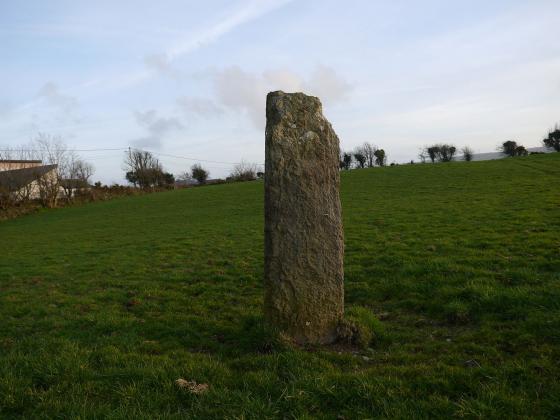
Looking down at the monument from the higher ground to the northwest.

Looking down at the monument from the higher ground to the northwest.

The ‘internal’ view of the blade-like, free, upright stone.

The western side of the setting, showing the two quartz stones, one free and one buried in the hedge.

The eastern side of the arrangement showing the hedgefast quartz pillar rising over the prostrate sandstone.

Glanbrack is the pale shape in the corner of the field to the east.

Lettergorman South can be seen near the hilltop to the north.
Possibly the most intriguing site in the whole Argideen/Rosscarbery area – four stones, three of quartz; a unit of two sets of parallel pairs, rising from the spine of the hill. Two of the quartz stones, the southernmost of each pair, are included in the fence. The western rock is recumbent but the eastern is standing, 2.3m distant*. The third juts 1.4m north of and parallel to, the western stone.
The remaining slab, of sandstone, was recently tumbled (by cattle) from a position 1m north of the eastern rock and its southern tip now points to the base of its partner in the wall. All, assuming the recumbent quartz is fallen, would have stood in an ENE-WSW arrangement of fairly uniform appearance – each around 1m in height.
The slope is east facing but, at this particular location on the hill, it is possible to see clearly to the north, east and south. The view is only restricted to the west. It is also a position in which the monument itself could be seen from many directions, but from a distance. If the quartz boulder at Lettergorman S is an original feature its placing may reflect this – the white stones of Maulatanvally are bright on the horizon if you gaze out from the circle and over the top of the rock.
*All measurements taken from Archaeological Inventory of Cork, 1992; No.921, 112.
“There was an ancient forest which no axe had ever touched, and in the heart of it a cave, overgrown with branches and osiers, forming a low arch with its rocky walls, rich in bubbling springs. Hidden in this cave dwelt the serpent of Mars, a creature with a wonderful golden crest; fire flashed from its eyes, its body was all puffed up with poison, and from its mouth, set with a triple row of teeth, flickered a three-forked tongue.”
Cadmus, son of King Agenor of Sidon, struggled with and defeated the monster...
“Then Pallas, the hero’s patroness, suddenly appeared, gliding down through the upper air. She told him to plough up the earth, and to sow the serpent’s teeth, as seeds from which his people would spring.”
from ‘The Founding of Thebes’; Ovid, Metamorphoses, Book III.



























































































